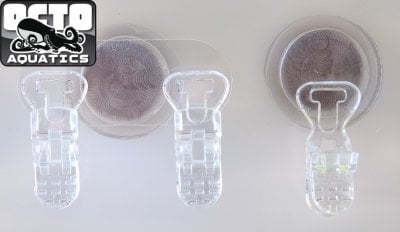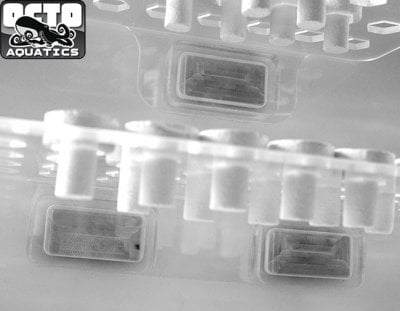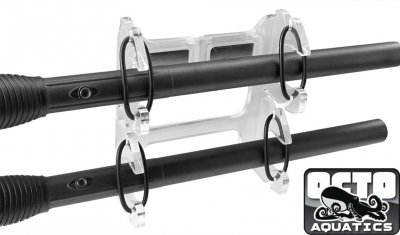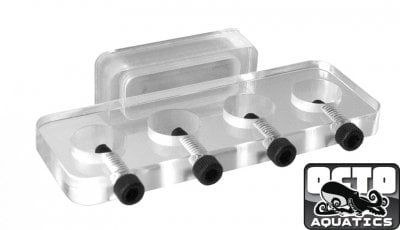This article is sponsored by
Who doesn't love playing with magnets? I do. Magnets are very handy for attaching equipment to our tanks - frag racks, probe holders, float switches, filter sock holders, small skimmers...etc. How do you know if the magnets you're using are "reef-safe"? I'm going to break down the two main types of magnets commonly used in our aquariums and cover the pros and cons of each. Using the wrong type of magnet can have adverse effects on your tank's inhabitants, so this information is very important, especially for those who like to DIY. Like myself.
For the purpose of this article I'm not going to cover insane detail about all the different magnet properties, just what applies to us aquarists.
The two most common magnet types found in our hobby are: Neodymium (rare earth) and Ferrite (ceramic). Magnets are rated in "pull force." This is the amount of force (usually measured in pounds) it takes to separate two magnets from each other. The pull force is important to us because if the pull force isn't strong enough, you can't hold up your equipment.
Ferrite Magnets:
By Omegatron - Own work, CC BY-SA 3.0
Pros - Cost effective, they are corrosion resistant which make them somewhat reef safe, readily available at big box stores, craft stores, etc.
Cons - Their pull force is very low.
Conclusion - Great for use on your refrigerator!
Neodymium Magnets:
Source: Wiki Creative Commons Attribution 1.0 Generic license.
Pros - Pull force, pull force, PULL FORCE!
Cons - Can be expensive (up to several hundred dollars for one magnet), can be more difficult to find locally, very corrosive (NOT reef-safe), their strength makes them dangerous to people, pets and property.
Conclusion - The only magnet I use for aquarium related products.
Neodymium magnets are graded according to their maximum energy product, which translates to pull force. The higher the number, the greater the pull force, the highest being N52. As I stated earlier, these magnets can be dangerous - seriously! In fact, I use this magnet disclosure:
Important Safety Warning!
Read Before You Order and Use the Magnets
Disclaimer: XXX™ assumes nor accepts any liability for damages resulting from the handling or use of magnets. With your purchase, the buyer confirms that you have read and understood the following warnings, the buyer agrees that he/she is responsible for all damages and injuries caused by the magnets, which include personal injuries , property damages and magnet damages. The buyer must agree with the terms before purchase. Pull forces we provide are estimates only and we are not responsible for any inaccuracy of magnet pull force. Please test the pull force before any usage.
The neodymium magnets we use are very strong. Handling them with care is necessary to prevent personal injuries, property damages and magnet damages.
Magnets can cause serious damage to fingers if caught between 2 magnets such as breaking bones or losing finger tips.
- Neodymium magnets are brittle; they can be broken or can splinter in a collision. One should wear gloves and protective glasses when handling these magnets, because splinters and/or spacers could disengage and fly from the magnets.
- Normal neodymium magnets will lose their magnetic properties if heated above 175°F (80° C).
- The strong magnetic fields of neodymium magnets can damage items such as televisions, computer monitors, credit cards, bank cards, computers, diskettes and other data carriers, video tapes, mechanical watches, hearing aids, loud speakers and VCRs. Pace-makers may be damaged or switch to “Test Mode” in the presence of a strong magnetic force, if a pace-maker or other electrical body implant is in use, keep a minimum of 3 feet distance.
- Children should not be allowed to handle neodymium magnets as they can be dangerous. Small magnets pose a choking hazard and should never be swallowed or inserted into any part of the body.
- Under no circumstances should you try to cut, saw or drill the neodymium magnets! Not only would the magnet break, but the resulting dust from the magnet is very flammable. Neodymium magnets should never be burned, as burning them will create toxic fumes.
- ALWAYS have a firm grasp on magnets.
- NEVER let magnets lie within 12” of each other and any other metal object.
- ALWAYS keep out of reach from children.
- DISCONTINUE use if water enters waterproof capsules. Magnets are not reef-safe.
- NEVER let magnets “slap” together as they are brittle and can break.
And check out this press release:
NEWS from CPSC
U.S. Consumer Product Safety Commission
Office of Communications Washington, D.C.
FOR IMMEDIATE RELEASE
November 10, 2011
Release #12-037 CPSC Media Contact: (301) 504-7908
CPSC Warns High-Powered Magnets and Children Make a Deadly Mix
WASHINGTON, D.C. – An increasing number of incident reports to the U.S. Consumer Product Safety Commission (CPSC) indicate that high-powered magnets continue to be a safety risk to children. From toddlers to teens, children are swallowing these magnets and the consequences are severe.
Although the risk scenarios differ by age group, the danger is the same. When two or more magnets are swallowed, they can attract one another internally, resulting in serious injuries, such as small holes in the stomach and intestines, intestinal blockage, blood poisoning and even death.
Reports of incidents involving these high-powered ball-bearing magnets have increased since 2009. Specifically, CPSC received one incident report in 2009, seven in 2010 and 14 through October 2011. These 22 incidents have involved children ranging in age from 18 months to 15 years old. Of the reported incidents, 17 involved magnet ingestion and 11 required surgical removal of the magnets. When a magnet has to be removed surgically, it often requires the repair of the child’s damaged stomach and intestines.
“We want parents to be aware of the danger associated with these innocent looking magnets,” said CPSC Chairman Inez Tenenbaum. “The potential for serious injury and death if multiple magnets are swallowed demands that parents and medical professionals be aware of this hidden hazard and know how to treat a child in distress.”
High-powered magnets and magnet components that are of a size that can be swallowed are prohibited in toys for children younger than age 14. The reported incidents involve magnets that are marketed as desk toys and stress relievers for adults who use the magnets to create patterns and build shapes. Often, they are sold in sets of 200 or more magnets in stationery, office supply and gift stores, and also on the Internet.
CPSC has received reports of toddlers finding loose pieces of magnets or magnets left within reach. It can be extremely difficult for a parent to tell if any of the tiny magnets are missing from a set. In some of the reported incidents, toddlers have accessed loose magnets left on a table, refrigerator, sofa or the floor.
With tweens and teenagers, how the product is being used has resulted in magnets being unintentionally inhaled and swallowed. CPSC is also aware of instances where the magnets were swallowed intentionally. To mimic body piercings, the older children are placing two or more magnets on opposite sides of their ear lobes, tongue and nose.
“We sell our magnetic desk toy product, Nanospheres,® on Amazon.com for adults only. As the Amazon product description and warning labels on the product itself state, these products are hazardous if ingested and are not appropriate for young children,” said Dan Taggert, CEO of Kringles Toys and Gifts, manufacturer of Nanospheres.®
“High-powered magnets, such as Buckyballs,® are products for adult use only and should be kept away from all children,” said Craig Zucker, CEO of Maxfield and Oberton, the manufacturer of Buckyballs.
CPSC, Kringles Toys and Gifts and Maxfield and Oberton are urging consumers who have purchased magnet sets for children younger than 14 years of age (or households with children under 14 years of age) to remove access to the sets by children immediately and contact the firms for a refund.
* * *
Although this is CPSC’s first product wide public warning about high-powered ball-bearing magnets used in adult products, the agency has issued safety alerts previously about the dangers of powerful magnets falling out of children’s toys. In April 2007, CPSC issued a warning about the possibility of high-powered magnets detaching from children’s toys, such as building sets, causing injuries and death. At that time, CPSC was aware of the death of a 20-month-old child and of 33 incidents involving children who had swallowed magnets. Of these 33 incidents, 19 children required surgery to remove the magnets. Since 2008, CPSC has received more than 200 reports of children swallowing magnets and at least 18 of those children required emergency surgery to remove the magnets.
In an effort to reduce the incidents associated with magnets, CPSC staff worked with the toy industry and other stakeholders to develop a standard to prevent magnets from detaching from toys. As of 2008, this standard is mandatory, and it prohibits magnets and magnet components that are loose and of a size that could be swallowed to be in toys for children under 14 years of age.
* * *
Based on the number of incidents involving young children accessing magnets intended for adults, as well as the growing number of teenagers misusing the product, CPSC again has been prompted to launch a magnet awareness campaign. This multipronged initiative includes a grassroots effort with public safety partners, public service videos targeted for parents and teenagers, along with social media outreach. CPSC is warning parents and medical professionals about the extreme danger facing children who swallow multiple magnets.
CPSC offers the following tips to avoid magnet ingestion injuries and advice on what to do if you suspect that your child has swallowed magnets:
- Keep small magnets away from young children who might swallow them.
- Look out for loose magnet pieces – and regularly inspect toys and children’s play areas for missing or dislodged magnets.
- If you suspect that magnets have been swallowed, seek medical attention immediately.
- Look for abdominal symptoms, such as abdominal pains, nausea, vomiting and diarrhea.
- Note that in x-rays multiple magnetic pieces may appear as a single object.
Wait...... if neodymium magnets are the best option for us, how can we use them if they're not reef-safe?
Many, many years ago when I started working with plastics, I started making acrylic pods to house my magnets in. Fast forward to today and there are several manufacturers out there who are doing the same thing. I've seen them made out of not just acrylic, but also abs. Some people will even coat their magnets in epoxy. I do not recommend this as certain epoxies can become brittle over time.
The key to the plastic pods is they have to be water tight. If any water leaks into the pod, the magnet will corrode and that's not good for your tank. Here's one of my un-assembled pods:
And here are some other plastic magnet pods that didn't turn out too well:
Neptune MPR Probe Holder
Photo credit: Antonio Gutierrez
IM Gourmet Defroster
Photo credit: Brian DeVillier
Ecotech Vortech MP Pumps
Photo credit: NAx0
Eshopps Frag Rack
Photo credit: Author
Eshopps again.
Photo credit: Author
I was able to pull these Eshopps pods apart with just my fingers. It appears they were laser welee’s, which explains the poor seams.
*** If you have photos of rusty magnets, please pm me so I can include them in this article. ***
Here are some of my magnet pods attached to various products. You'll notice the big difference between mine and others is the size of the pod. My pods have thicker walls which creates more surface area to weld. The ones pictured above have very thin pod walls and the bond isn't very strong, which allows them to split apart over time. They may also be laser welded which also creates a very thin bond. If you are going to DIY your own magnet pods, then I highly suggest utilizing a thicker pod wall design.
(Photos are for illustration purposes; however, these items can be purchased at www.octoaquatics.com.)




Last edited:






















